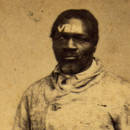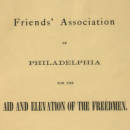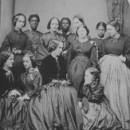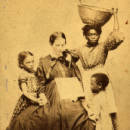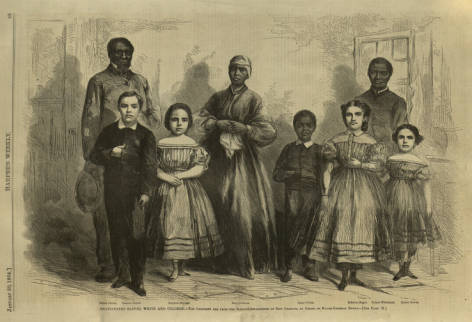
White Slaves
By Celia Caust-Ellenbogen
Swarthmore College, Class of 2009. Quakers & Slavery Digitization Project Intern
Featured Image:LEARNING IS WEALTH: WILSON, CHARLEY, REBECCA & ROSA, Slaves from New Orleans. Quakers often purchased photographs that, like this one, were sold as
fund-raisers to support freedmen's relief work. This particular photograph was mixed
amongst portraits of relatives and friends in a photograph album belonging to the
Trumans, prominent Philadelphia-area Friends. (link to a detailed inventory of the
Truman-Underhill Album Collection) (see all references to Truman family members in the Quakers & Slavery
Collection)
|
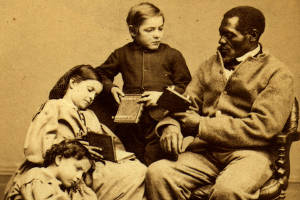 |
The Emancipation Proclamation and Freedmen's Relief
When Abraham Lincoln's Emancipation Proclamation took effect on 1 January 1863, thousands of slaves living in the rebelling Confederate States found that they had been instantly "freed." Technically speaking this was true, but the logistics involved in actually restoring a free and equal status to the newly emancipated slaves was, to say the least, staggering. Without money, education, or experience fending for themselves--not to mention the additional challenges of living in a war-torn and racially-prejudiced county--the former slaves faced seemingly insurmountable challenges to finding some means of subsistence. Northerners and abolitionists quickly deployed relief organizations, such as the Friends Association of Philadelphia for the Aid and Elevation of the Freedmen. These groups worked tirelessly to acquire supplies, establish schools, and provide other forms of support, but resources were limited. Moreover, it was not easy to arouse the sympathy of countrymen who were preoccupied by war, and more often than not ambivalent on the issue of African-American slavery.
By December of the same year, 1863, much of Louisiana was occupied by the Union army. Ninety-five schools serving over 9,500 students--including almost half of the black children in Louisiana--were running under its auspices (Clinton 58). But keeping these schools up and running would require ongoing financial support. Toward this end, the National Freedman's Association, in collaboration with the American Missionary Association and interested officers of the Union Army, launched a new propaganda campaign. Five children and three adults, all former slaves from New Orleans, were sent to the North on a publicity tour. A drawing of them was printed in the 30 January 1864 issue of the popular Harper's Weekly, bearing the intriguing caption: "EMANCIPATED SLAVES, WHITE AND COLORED." The authors of this campaign were pursuing a surprising, and quite effective, strategy for arousing sympathy for blacks--they portrayed them as white.
The Publicity Tour
Of the eight slaves sent north from New Orleans, four children--Charley, Augusta, Rebecca, and Rosina (Rosa)--looked white. As the article accompanying the group portrait in Harper's Weekly affirmed, they were "perfectly white;" "very fair;" "of unmixed white race". Their light complexions contrasted sharply with those of the three adults, Wilson, Mary, and Robert; and that of the fifth child, Isaac--"a black boy of eight years; but none the less intelligent than his whiter companions".
Accompanied on their tour by Col. George Hanks of the Corps d'Afrique (the 18th Infantry, a corps of colored soldiers), the group posed for photographs in New York and Philadelphia (Metropolitan Museum of Art). The portraits were produced in the format of cartes de visite (CDVs), albumen prints the size of a calling card, and sold for 25 cents each. The proceeds of the sale were directed to Maj. Gen. Nathaniel P. Banks in Louisiana, where the money would be "devoted to the education of colored people," as the verso of each photograph explains.
Of the "Emancipated Slaves from New Orleans" series, at least 22 different prints remain in existence today. The bulk were produced by New York photographers Charles Paxson, and Myron H. Kimball, who took the initial group portrait later reproduced as a woodcut in Harper's Weekly. At least one CDV remains by Philadelphia photographer James E. McClees: a portrait of Rebecca.
White Slaves(clockwise): REBECCA, AUGUSTA and ROSA, Emancipated Slaves, from New Orleans; Rosa. A Slave Girl from New Orleans; FREEDOM'S BANNER: CHARLEY, A Slave Boy from New Orleans |
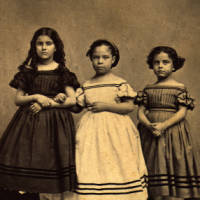 |
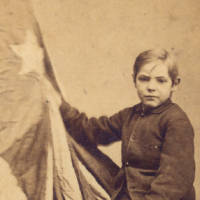 |
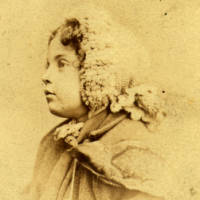 |
Analysis of the Images
The tremendous success of the "White Slaves" propaganda campaign has been under increasing scrutiny in recent years. Scholars of history, photography, and cultural studies have formulated a number of interesting arguments to explain the appeal these images may have had for contemporary viewers.
In "Rosebloom and Pure White, Or So It Seemed," Mary Niall Mitchell points out that by depicting slaves as white, the photographs made an argument for the Civil War that was independent of class status. Southern slavery was a threat to the freedom of all white people, the photographs insisted; thus repudiating the notion, made dangerous by the New York draft riots of 1863, that the Civil War was purely an elitist conflict waged with the blood of the poor (Mitchell 58) In the same article, Mitchell also highlights the significance of the fact that the majority of the photos in the series were portraits of young, white, and well-dressed girls. Such portraits took advantage of the patronizing tendencies of the northern Victorian public, calling upon the viewer to protect the purity, innocence, and "whiteness" of youthfulness and femininity (Mitchell 72).
In "Visualizing the Color Line," Carol Goodman notes that much of the power of the photographs stemmed from allusions to physical abuse. When paired with a related article in the same issue of Harper's Weekly, the allusions in the portrait of white slaves to the white masters' sexual exploitation of their female slaves is clear. The most grievous sin of slavery, the editor of Harper's Weekly contends, is that it permits slaveholding "'gentlemen' [to] seduce the most friendless and defenseless of women". Moreover, two of the four black slaves included in the publicity tour bear the marks of abuse on their skin--Wilson has a brand upon his forehead; Mary, as she is described in Harper's Weekly, has more than 50 rawhide-scars on her arm and back. (Goodman)
Gwendolyn DuBois Shaw, in Portraits of a People, considers the ways props were used to imply that the subjects shared the viewers' values. Several portraits taken by Charles Paxson figure the American flag prominently in the composition, such as "Freedom's Banner." Another of Paxson's photographs, "Learning is Wealth," depicts each of the subjects holding a book--which, moreover, recalls the purpose behind the whole project, raising money for schools in Louisiana. (Shaw 160).
Rebeccaphotographed by (clockwise): Charles Paxson, New York; James E. M'Clees, Philadelphia; Myron H. Kimball, New York |
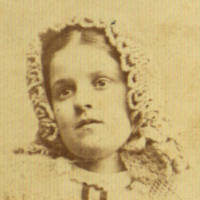 |
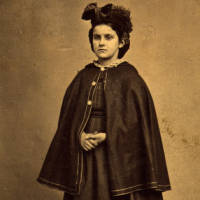 |
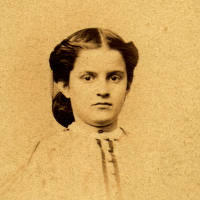 |
References
Clinton, Catharine. "Orphans of the Storm: Steering a New Course." In Civil War Stories. Athens, GA: University of Georgia Press, 1998. 41-80.
Goodman, Carol. "Visualizing the Color Line." From Mirror of Race online exhibition by Suffolk University. http://www.mirrorofrace.org/carol.php.
Harper's Weekly. Vol. 8 No. 370 (January 30, 1864): 66, 69, 71.
Metropolitan Museum of Art. "Emancipated Slaves" by Myron H. Kimball. Accession number 2005.100.92.
Mitchell, Mary Niall. "Rosebloom and Pure White, Or So It Seemed." In Raising Freedom's Child: Black Children and Visions of the Future after Slavery. New York: New York University Press, 2008. 51-90.
Shaw, Gwendolyn DuBois. Portraits of a People: Picturing African Americans in the Nineteenth Century. Seattle: University of Washington Press, 2006. 154-161.

